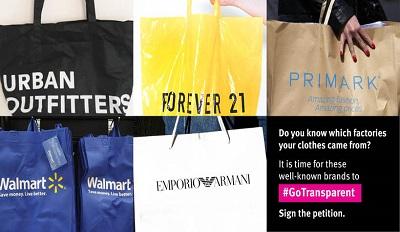
Originally published in Huffington Post
Just before the fourth anniversary of the collapse of Rana Plaza, the most fatal tragedy in the history of manufacturing, a coalition of human rights advocates are calling for greater transparency in the global apparel industry. The report, Follow the Thread: the Need for Supply Chain Transparency in the Garment and Footwear Industry, is the base document for a new drive by the global trade unions and labor rights advocacy organizations to demand greater transparency from apparel brands. The report is based on letters sent to 72 brands, asking them to publish the names, addresses, and other important information about factories manufacturing their products. Of those brands, 17 agreed to align with the pledge, a powerful tool for promoting corporate accountability that allows garment workers, unions, and nongovernmental organizations to call on these apparel companies to help ensure that abuses stop.
The collapse of Rana Plaza, which killed 1,134 workers in Bangladesh and injured more than 2,000, came months after a string of factory fires in Pakistan and Bangladesh that led to the deaths of more than 370 primarily women workers. Each tragedy triggered a multi-year struggle to secure compensation for the injured workers and the families of the deceased, including global demonstrations and campaigns. Uncountable hours were wasted as workers, unions and NGOs struggled to establish connections between the factories and the brands whose clothes they produced – and then convince those brands to support the worker compensation fund. Bangladeshi law does not provide any guarantee of compensation following injury or death, which is crippling for families who have lost their primary breadwinner. In the end, Rana Plaza victims waited more than two years for compensation, while the victims of less high profile cases waited longer or never received anything because the brands quietly walked away.
Shamefully, these delays prolonged the victims’ suffering and plunged them even further into poverty as debts mounted, medicines ran out, and children’s educations were disrupted. The amount of time spent on the cat–and-mouse game of having to figure out which brands were buying from which factories was incredibly wasteful. And some brands, like Walmart, contributed much less than their fair share. The majority of the clothes found after the 2012 fire at Tazreen Fashions, which killed 112 workers, was Walmart labeled product. Yet Walmart initially claimed that because the factory was no longer on their approved list, they had no reason to contribute to the worker compensation fund. Notably, while Walmart acknowledged receipt of correspondence about the Transparency Pledge, they did not indicate any commitment to publish their supplier factories, and they are one of five companies targeted by the Follow the Threadcampaign launched in conjunction with this report.
To be sure, supply chain transparency will not address the root causes of labor rights violations: the brands’ perpetual search to reduce production costs. Without strong, independent unions to lift up worker voices and brands’ making commitments to ensure factories address problems that workers’ identify, no amount of information can prevent a future tragedy.
On the morning that Rana Plaza collapsed, workers could see cracks in the building and knew it was unsafe. Still, the factory managers forced them inside, to keep on pace with the brands’ orders. In a future where brands are transparent about where they produce, and when workers have a trade union, the union could call brand representatives directly and tell them about the cracks. Would The Children’s Place or Benetton refuse to adjust their order expectations in order to save lives? We certainly hope so! Combining the Transparency Pledge with ongoing dialogue and contractual commitments between brands and unions is a way to keep workers safe and help brands regain credibility.
Gone are the days where brands could claim that to publish their supplier lists would somehow harm their competitiveness. Not only do the growing number of brands already disclosing those lists disprove this, but in a post Rana world, transparency must become the norm.

